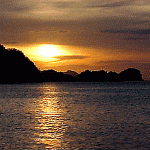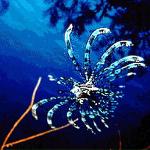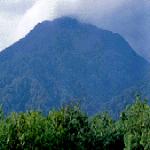The Six Regions of Malaysia
Malaysia is simply divided into six main regions, namely the Northern Region, Central Region, Southern Region, East Coast, Sabah, and Sarawak. You may break your visits down to several specific regions or better still, if time permits, visit the whole country. The best part about Malaysia is its size. It is small enough for you to take in everything yet not too big to terribly tire you out. It is a little place with everything "under one roof" (almost literally so). In Malaysia, you will get to sample a great variety of delicious mouth-watering ethnic dishes, a plethora of cultural arts and music, as well as experience the many different races and lifestyle of ethnic groups. Although the country is small, yet as you step into each state, you will see and feel a different culture altogether. This is more apparent in the East Coast, and Sabah and Sarawak. Without further ado, let's take a brief journey down all six regions of Malaysia:
Northern Region
The northern region is made famous by a couple of states. Well, no. I would be most biased to say that. In actual fact, each of the states in the northern region is fabulous in its own rights. The northern region comprises of Perlis and Kedah, the two northernmost states. This is followed by Penang and Perak. Perlis is the smallest state in the country, a mere 810 sq. km only. Although the smallest yet Perlis has established itself over the years as a progressive state in the historical scene. It has existed since pre-historic times with proofs in the form of ancient remains at Teguh Lembu Cave (Tengku Lembu) in Beseri. However, small as it is, it was overshadowed by the Kedah Sultanate - Kedah and Perlis are both rich lands with gentle slopping plains. These two areas make up the majority of paddy growing regions in Malaysia. It is aptly nicknamed the "Rice Bowl of Malaysia".
The states in the northern region is mainly rich in history and culture, thus if you are someone who enjoys sights like these, you must make it a point to visit the northern region. Most of its places of interest are made up of idyllic islands, beaches, plantations, rainforests and ancient historical sites, which surround the towns and cities. This is where the famous Langkawi Island can be found as well. Another popular island location, Penang or Pulau Pinang, is the first British outpost in Southeast Asia. A popular holiday destination for both international travelers and locals as well, Penang is also known as the "Pearl of the Orient". This charming little state is a picturesque place as it has a combination of both old and new, east and west. Penang has managed to retain this charming flavor for a very long time despite the rapid urban development.
Moving on to the state of Perak, you will see a change in landscape. An area of rocky limestone outcrop, Perak used to be home to one of the world's richest tin-mining areas. This rich land was also the birth land of Malaysia's rubber industry. Other forms of economy in Perak include fishing, vegetable farming, plantations and fruit growing, whereas the industrial development focuses mainly on small and medium based manufacturing.
Central Region
The middle sector of the country, or "politically-correctly" known as the central region, comprises mainly of the "happening" states. Here is where the hub of the nation is located, the fun zones and the main governmental offices. The central region has only two states, namely the states of Selangor and Negeri Sembilan. The state capital of Selangor is called Shah Alam. The areas of Selangor surround the Federal Territory of Kuala Lumpur, which is the capital of Malaysia. Most of the exciting agendas, state meetings, lifestyle & entertainment spots as well as delicious cuisine can be found in Klang Valley, Selangor's main development center. Selangor is also the country's most developed state. Klang Valley encompasses and stretches all the way from Kuala Lumpur to Port Klang, the country's main and busiest port on the west coast of the country. The port overlooks the Straits of Melaka.
Selangor is also where we get the Multimedia Super Corridor (MSC) - the country's IT arm, the ultramodern Kuala Lumpur International Airport (KLIA) that is located in Sepang, lots of smart buildings, and industrial zones.
There could be no other more sophisticated state in the country than Selangor at this very moment! The capital of the country has progressed remarkably well over the past century, turning it from a tiny muddy-looking town with attap thatched roofs on most buildings to being the home to one of the world's tallest building!
Now, Kuala Lumpur is a bustling cosmopolitan city, bursting with modernity and high-tech buildings. It is truly a shopping paradise too. Despite the rapid change, Kuala Lumpur has not lost its charm and heritage. It is because of the fusion of old and new that many tourists have found Kuala Lumpur to be a fascinating land.
To see the new Kuala Lumpur, head for the Golden Triangle and the areas around Bintang Walk, where classy sidewalk cafes and restaurants line the street next to a number of huge shopping complexes. For a taste of the old intrinsic charm, make your way to the old Chinatown or Petaling Street for a bout of night shopping and bargaining.
The food found within this area is superb and each is a niche of its own! Everything is down-to-earth cheap, but you will need to put on a little bargaining cap and also be aware of a few conmen on the streets. Crime level on the older side of Kuala Lumpur is still relatively low although it is advisable for a visitor to be extra careful of pickpockets. On the other hand, the modern areas of Kuala Lumpur are less of a threat. You can walk around the place with peace of mind although it is in the wee hours of the morning. Malaysia is still, on a whole, a relatively safe country.
Moving out of Selangor and Kuala Lumpur, the other state located in the central region is Negeri Sembilan. The name, when translated, literally means "nine states". This is a small state with a rural landscape dotted with some areas of modern living. Negeri Sembilan is most famous for their Minangkabau traditions. You can see this tradition alive on majority of the state's architecture layout. Check out the old kampung houses or official buildings. Negeri Sembilan was formerly an agriculture state but over the years, the economy has picked up and the hands of modernization have touched the state. Now, agricultural and industrial economies are quite balanced. Unlike Selangor and Kuala Lumpur that is always rushing to be on top of the progressive charts, Negeri Sembilan takes a leisurely stroll down the lane. Most of the state's development can be seen in its capital city, Seremban, where industrial parks are slowly sprouting around the fringe of the city. Asides from that, the state remains a green lung to its surrounding areas with careful considerations before any of its nature is surrendered for development.
Southern Region
The southern region has one of the best tourist spots around the country, or as some claimed, around the world! The southern side of Peninsular Malaysia comprises of the states of Melaka and Johor. If you are one who is interested in history, then the southern region is the place for you. Malaysia's Historical City is Melaka, a place that is filled with cultural and historical aspects. Its heritage was set many years ago, thanks to its centralized location as one of the world's most famous trading post. This was the place where many rich and important traders and European conquerors made their home many years ago. The remnants of ruined buildings and fortresses speak a thousand words. Its glorious past is still very much a part of the tourist attractions in Melaka. For those who are interested in quaint antiques and other old artifacts, Melaka is the place for you. If you have the time to spare, slowly take your time going through some of the little shops in the town center. You will be surprised at the kind of treasures you can possibly find. Melaka is also a food haven, with their popular cuisine being that of the Baba & Nyonya's or Peranakan food. Mainly on the spicy side, these dishes promise to tingle your taste buds and make you wanting more.
Johor is the southernmost state of the Peninsular. This is the state that links Malaysia to its neighboring country, Singapore. Detached via the Causeway, Johor has a lot to offer. Because of its proximity to Singapore, residents of the state of Johor gets certain perks such as Singapore television programs. Many residents of Johor are also able to find jobs in Singapore, thus traveling to and fro the country everyday. The downside of its closeness is the high-cost of living that is influenced upon the state. Eating out and purchasing goods in Johor is relatively a notch higher than most states in the country. Therefore, if you would have to spend money on products, it is better to head on over to Singapore.
On the nature end of the state, Johor is made out of huge stretches of fruits and oil plantations. It is especially famous for the production of pineapple. Since Johor is quite a big state, there are stretches of wilderness, beaches and beautiful coral islands that have never failed to woo tourists from all over the place. If you want to laze and bask in the sun, Johor is the place for you. In terms of history, Johor has a heritage dating way back to the 17th century. Just like Melaka, Johor has its own distinctive cuisine, handicraft and cultural attractions. Most of its charm and history is clearly reflected on its buildings.
East Coast
The East Coast of Malaysia is made up of Pahang, Kelantan and Terengganu. Kelantan and Terengganu can be considered very different from all the other states in Peninsular Malaysia. These two states have very strong Malay culture mixed with some Thai elements. Being in Kelantan and Terengganu somehow seemed to draw you back to an ancient time. This is especially so for the state of Kelantan, where it is looked upon as the main branch of the Malay culture.
Kelantan is famous for its fishing activities, agriculture and cottage industries. It is also highly famous for its kite flying and giant top spinning festivals! These two activities have proven to be a favorite past times for the people who lived there, and had been so for many years. Terengganu on the other hand is a land highly acclaimed for its beautiful coral islands, sandy beaches and quaint fishing villages. This is also the place where you can see the giant leatherback turtles laying their eggs during certain months on the beaches of the famed Rantau Abang (there are others, of course). Just like Kelantan, Terengganu also enjoys recreational pursuits like kite flying and top spinning activities.
The other state within the east coast region is Pahang, home to all nature lovers. This is the place comprising of acres and acres of tropical rainforests, leisure islands and of course, the highest mountain on the Peninsular.
Gunung Tahan, the backbone of the Peninsula, provides for a rather rugged outlook where many interesting and rare flora and fauna lived. It is here that you will find the best in eco-tourism.
The famous Taman Negara, the country's national forest reserve, is also found in the state of Pahang. A visit to Pahang promises lots of adventure. Other popular highlands retreats that are located in Pahang include the famous Genting Highlands, Cameron Highlands and Fraser's Hill.
Genting Highlands is home to the only legalized casino in the country. Just a short drive from Kuala Lumpur, Genting Highlands is the perfect spot for a day trip. Aside from the casino, this highland resort has also prepared an indoor and outdoor theme park for the whole family. Accommodation at the newly built New World Hotel is also highly affordable.
Cameron Highlands on the other hand is widely known as the perfect destination for a "holiday in the sky". This highland resort is higher than Genting Highlands and would require a tough stomach to survive the drive up the windy roads. Once there, the refreshing breeze and cool air will revive even the most stressed-out person. Do visit the strawberry and mushroom park on Cameron Highlands. You can buy fresh strawberries on the spot and eat it with sugar and cream. Flowers such as roses and carnations are also very cheap here. I once bought 100 stalks of white roses for only RM10 (10 ringgit = USD2.60). The vendors even threw in the bucket for me to carry the flowers home fresh!
I have not been to Fraser's Hill in a while, but I do remember this place to be the perfect location for a "dine & chill out" spot! For nature lovers, Fraser's Hill has a "Fraser's Hill Nature Education Center" run by the WWF Malaysia organization. Do drop by this center if you are around the area.
Sabah and Sarawak
Last but not least, the final two regions are made up of Sabah and Sarawak. It is easier to put the two together as it is like a world of its own. Separated from the Peninsular Malaysia, the states of Sabah and Sarawak are considered "East Malaysia". Occupying the northwest section of Borneo, these two states are also sitting on what is known as the largest inhabited island in the world. The two states have a rugged landscape with large undeveloped areas that is made up of rainforests, rivers, caves, islands and islet. Many of these areas are yet to be discovered.
It is also here that you will find an incredibly diversified variety of flora and fauna, including the world's largest primate, the Orang Utan. Aside from the largest primate, you will also be able to see the world's largest flower, the Rafflesia. Like enveloped in a world of its own, East Malaysia is a wondrous world that is so wonderfully "natured" that you can find unique varieties of plants including the insect-gobbling pitcher plants, wild orchids and ferns. All these have never failed to enthrall a visitor to the place before.
Sabah and Sarawak is truly a land for thrill-seekers, adventure buffs and eco-tourism. Sabah is also home to Southeast Asia's highest mountain, Mount Kinabalu. If you have read my previous articles, you will also know that Sabah and Sarawak have many forest reserves and national parks. Visitors who enjoy caving must visit Niah Caves (Gua Niah), a caving system with many hidden secrets and history.
There are also marine parks in both the states. These are untouched havens, natural habitats to a large variety of beautiful marine flora and fauna. The crystal clear waters are positively inviting. At most of these sites, there are good diving facilities and comfortable accommodations for divers. Looking for a little action? You can head on over to the rivers for a white-water rafting thrill. There are also boat cruises that you can take to slowly enjoy the wildlife seen loitering around the banks of the river and wetlands. Sabah and Sarawak are also rich in cultural heritage as seen from their handicraft and architecture of the longhouses. You may opt to stay at a longhouse while visiting the place. At the end of the day, everything that you can possibly get from Sabah or Sarawak is the epitome of the Malaysian culture and heritage. A mixture of old and new, modern and cultural, urban or rural! A visit is a must.
* * * * *
 ThingsAsian
ThingsAsian

















